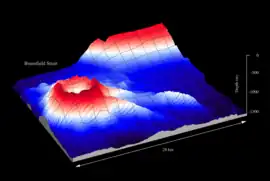| Orca Seamount | |
|---|---|
 Bathemetric mapping of the seamount, mapped with the swath sonar system of RV Polarstern during cruise ANT-XI/3. | |
 Location of Orca Seamount | |
| Height | ~500 m |
| Location | |
| Location | Near King George Island, Antarctica |
| Coordinates | 62°26′00″S 58°24′00″W / 62.433334°S 58.400002°W |
| Geology | |
| Type | Underwater volcano (Seamount) |
Orca Seamount is a seamount (underwater volcano) near King George Island in Antarctica, in the Bransfield Strait. While it is inactive, last volcanic activity at Orca Seamount is judged to have occurred in the recent past as there are temperature anomalies in the seawater around the seamount.[1] Thermophilic and hyperthermophilic microorganisms have been found at the seamount.[1]
The crater rim is about 3 km wide and about 500 m above the ocean floor.[2]
The seamount was first named by Professor O. González-Ferrán of Chile in 1987, after the orca (killer whale) often sighted in these waters.[3][4] It was mapped and studied by the ship RV Polarstern during an Antarctic cruise (number ANT-XI/3) in 2005.[5] The variant name of Viehoff Seamount (approved in 6/95 ACUF 263) was named for Dr. Thomas Viehoff, a remote sensing specialist in marine sciences. Name proposed by Dr. G.B. Udintsev, Vernadsky Institute of Geochemistry (VIG).[6]
Geology
The submarine volcano is a Pleistocene-Recent shield volcano within the Bransfield Basin. The volcano has a base diameter of 20 km, and a height of 1000 m.[7] Samples obtained from Orca seamount were identified as basalt and basaltic andesites, suggesting the existence of more differentiated products, such as dacites or rhyolites.[8]
The area presents geodynamic extension conditions as a consequence of a complex interaction of the Scotia, Antarctic and ancient Phoenix tectonic plates.[9]
Seismic swarm of 2020-2021
In August 2020, the largest seismic swarm recorded in the history of the region began to occur. Between 36,000[10] and 85,000[11] earthquakes were detected in just a few months, with earthquakes up to magnitude 6.0. The swarm was located off King George Island, just a few kilometers from the Orca Seamount, which was thought to be extinct. Some studies indicate that the earthquakes were produced by magmatic intrusion, although there is no precise evidence that the volcano has erupted due to low instrumentation in the area.[11]
References
- 1 2 Rodrigo, Cristian; Blamey, Jenny M.; Huhn, Oliver; Provost, Christine (2018). "Is there an active hydrothermal flux from the orca seamount in the Bransfield Strait, antarctica?". Andean Geology. 45 (3): 344. doi:10.5027/andgeov45n3-3086.
- ↑ Hatzky, Jörn (2005): The Orca Seamount Region, Antarctica (Sect. 5.5.2). In: Peter C. Wille (ed.), Sound Images of the Ocean in Research and Monitoring, Springer-Verlag Berlin.
- ↑ "Name Details – Orca Seamount". Catalogue of Antarctic Names. Australian Antarctic Data Centre. Retrieved 2010-03-29.
- ↑ "GEBCO Gazetteer of Geographic Names of Undersea Features" (PDF). GEBCO Sub-Committee on Undersea Feature Names (SCUFN). January 2010. p. 332. Archived from the original (PDF) on 2016-03-03. Retrieved 2010-03-29.
- ↑ Vulcano bransfield-strait hg.png
- ↑ "Orca Seamount". Geographic Names Information System. United States Geological Survey, United States Department of the Interior. Retrieved 2018-08-11.
- ↑ Gonzalez-Ferran, O. (1991). Thomson, M.R.A.; Crame, J.A.; Thomson, J.W. (eds.). The Bransfield rift and its active volcanism, in Geological Evolution of Antarctica. Cambridge: Cambridge University Press. pp. 508–509. ISBN 9780521372664.
- ↑ "CHILE DESTACA ESTUDIOS REALIZADOS POR INGEMMET EN EL MONTE ORCA Y REFIERE ACTIVIDAD EN VOLCÁN SUBMARINO DE LA ANTÁRTIDA". www.gob.pe (in Spanish). Retrieved 2021-01-26.
- ↑ Peña, Juan Patricio (2020-09-25). "Orca, el monte submarino considerado un centro volcánico activo en la zona de los sismos en la Antártica". Emol (in Spanish). Retrieved 2021-01-26.
- ↑ Poli, Piero; Cabrera, Leoncio; Flores, María Constanza; Báez, Juan Carlos; Ammirati, Jean-Baptiste; Vásquez, Joaquín; Ruiz, Sergio (2022). "Volcanic Origin of a Long-Lived Swarm in the Central Bransfield Basin, Antarctica". Geophysical Research Letters. 49 (1): 1–9. doi:10.1029/2021GL095447. S2CID 245450444.
- 1 2 Cesca, Simone; Sugan, Monica; Rudzinski, Łukasz; Vajedian, Sanaz; Niemz, Peter (2022). "Massive earthquake swarm driven by magmatic intrusion at the Bransfield Strait, Antarctica". Nature. 89 (3): 1–11. doi:10.1038/s43247-022-00418-5. hdl:11585/883907. S2CID 248071330.